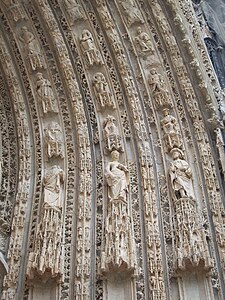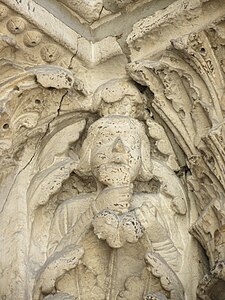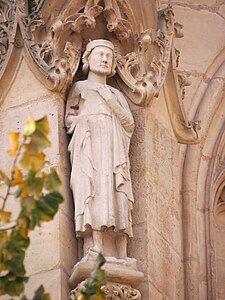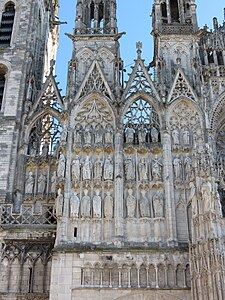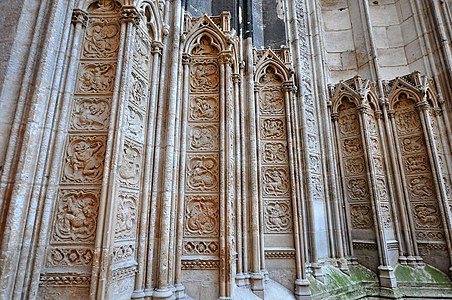
A | B | C | D | E | F | G | H | CH | I | J | K | L | M | N | O | P | Q | R | S | T | U | V | W | X | Y | Z | 0 | 1 | 2 | 3 | 4 | 5 | 6 | 7 | 8 | 9
| Rouen Cathedral | |
|---|---|
| Primatial Cathedral of Notre-Dame de Rouen | |
Cathédrale primatiale Notre-Dame de l'Assomption de Rouen (French) | |
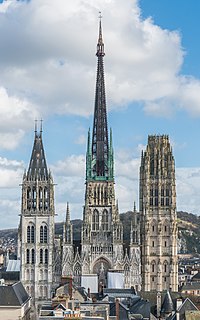 | |
 | |
| Location | 3 rue Saint-Romain 76000 Rouen, Normandy France |
| Denomination | Catholic Church |
| Website | rouen www |
| History | |
| Status | Cathedral |
| Dedication | Assumption of Mary |
| Consecrated | 1 October 1063 in the presence of William the Conqueror[1] |
| Relics held | Saint Romain |
| Architecture | |
| Functional status | Yes |
| Heritage designation | Classée Monument Historique |
| Designated | 1862[2] |
| Architectural type | church |
| Style | Gothic |
| Groundbreaking | 1030[1] |
| Completed | 1880 |
| Specifications | |
| Number of towers | 2 |
| Number of spires | 2 |
| Administration | |
| Archdiocese | Rouen |
| Clergy | |
| Archbishop | Dominique Lebrun |
| Priest(s) | Fr.Christophe Potel |
| Laity | |
| Organist(s) | Lionel Coulon |
Building details | |
 | |
| Record height | |
| Tallest in the world from 1876 to 1880 | |
| Preceded by | St. Nicholas' Church, Hamburg |
| Surpassed by | Cologne Cathedral |
| General information | |
| Coordinates | 49°26′25″N 1°05′42″E / 49.4402°N 1.0950°E |
| Height | |
| Antenna spire | 151 m (495 ft) |
| References | |
| [3] | |
Rouen Cathedral (French: Cathédrale primatiale Notre-Dame de l'Assomption de Rouen) is a Catholic church in Rouen, Normandy, France. It is the see of the Archbishop of Rouen, Primate of Normandy.[4] It is famous for its three towers, each in a different style. The cathedral, built and rebuilt over a period of more than eight hundred years, has features from Early Gothic to late Flamboyant and Renaissance architecture.[5][4] It also has a place in art history as the subject of a series of impressionist paintings by Claude Monet, and in architecture history as from 1876 to 1880, it was the tallest building in the world.[6]
History
First churches
Christianity was established in Rouen in about 260 by Saint Mellonius, who became the first bishop. The first church is believed to have been under or close to the present cathedral. In 395, a large basilica with three naves was built at the same site. In 755, the archbishop Rémy, the son of the Frankish statesman and military leader Charles Martel, established the first Chapter of the cathedral and constructed several courtyards and buildings around the church, including a palace for the archbishop.[7]
The cathedral was enlarged by St. Ouen in 650, and visited by Charlemagne in 769. However, beginning in 841, a series of Viking raids seriously damaged the cathedral complex.[8][9]
The Viking leader Rollo became first Duke of the Duchy of Normandy and was baptised in the Carolingian cathedral in 915 and buried there in 933. His grandson, Richard I of Normandy, further enlarged it in 950.[10]
In the 1020s, the archbishop Robert began to rebuild the church in the Romanesque style, beginning with a new choir, crypt and ambulatory, and then a new transept. The Romanesque cathedral was consecrated by the archbishop Maurille on October 1, 1063, in the presence of William, Duke of Normandy, soon to become William the Conqueror after his conquest of England in 1066.[10]
The Gothic cathedral

The project for a cathedral in the new Gothic style was first launched by the Archbishop of Rouen, Hugues of Amiens, who had attended the consecration in 1144 of the Basilica of Saint-Denis, the first Gothic structure, with its emphasis upon filling the interior with light. In 1145, he began constructing a tower, now called the Tower Saint-Roman, in the new Gothic style.[10]
A complete reconstruction of the cathedral was begun by his successor, Gautier the Magnificent. in 1185 he demolished the Romanesque nave and began building the western end of the sanctuary. He had completed the west front and first traverses when the work was interrupted by a major fire on Easter eve in 1200, which destroyed a large part of the town and seriously damaged the unfinished church and its furnishings. Gautier quickly repaired the damage and resumed the work, which was directed by his master mason, Jean d'Andeli. The nave was sufficiently complete by 1204 for King Philip II of France to be received there to celebrate the annexation of Normandy to the Kingdom of France. By 1207 the main altar was in place in the choir.[10]
The first architectural addition to the new church was a series of small chapels between the buttresses on the north and south sides of the nave, requested by the city's prominent religious brotherhoods and corporations. In 1280 the surrounding spaces and buildings were modified to permit the construction of portals on the north and south transepts. The next addition was a response to the growing role of the Virgin Mary in church doctrine; the small axial chapel at the east end of the apse was replaced by a much larger chapel dedicated to her, begun in 1302. The west front was also given new decoration between 1370 and 1450.[11]
Beginning in 1468 a highly ornamental new top, made of iron and covered with stone tiles, in the late Gothic Flamboyant style was added to the tower of Saint-Romaine.[11][12]
16th century – The Transition and the Renaissance
Cardinal-Archbishop Georges d'Amboise (1494-1510) had a major influence on the church architecture. He incorporated into the Gothic design new Renaissance features, as he had done in his own residence, the Château de Gaillon, The first major project of the period was a new tower to match the old Saint-Romaine tower, built almost three centuries earlier. Work on the tower had begun in 1488, under master builder Guillaume Pontifs, but under Cardinal d'Amboise in 1496 the project was taken over 1496 by Jacques Le Roux, who had a more ambitious plan with Renaissance touches. The Pope authorised Cardinal d'Amboise to grant dispensations to consume milk and butter during Lent, in exchange for contributions to the tower. The new tower soon took on the nickname of the Butter Tower, though the money collected paid only a portion of the cost. [11][13]
-
Cardinal Georges d'Amboise following Louis XII of France (1503)
-
Rouen and the Cathedral in 1525, from the "Livre des Fontaines" by Jacques Le Lieur.
As the new tower was being built, the west front of the Cathedral showed weaknesses and began to tilt. Cardinal d'Amboise ordered its complete reconstruction. This was carried out by master builder Rouilland Le Roux, nephew of Jacques Le Roux, in a lavishly ornate Flamboyant style. It was covered with layers of lacelike stone tracery, and hundreds of sculpted figures were added to the arch and niches of the portals. To stabilise the new facade, he added two massive buttresses, also richly decorated with sculpture. In addition to his changes to the Cathedral, the Cardinal and his architect reconstructed and decorated the Palace of the Archbishop close by, adding a new reception hall, galleries, gardens and fountains.[11]
In 1514 the flèche, or spire of the cathedral, a lead-covered wooden spire over the lantern tower, fell. It was replaced within a few months in exactly the same form and with the same materials.[11]
17th–18th century
-
The cathedral in 1664
In the late 16th century the cathedral was badly damaged during the French Wars of Religion: in 1562 the Calvinists attacked the furniture, tombs, stained-glass windows and statuary. The cathedral was again struck by lightning in 1625 and 1642, then damaged by a hurricane in 1683.[14]
In 1796, in the course of the French Revolution, the new revolutionary government nationalised the cathedral and transformed it for a time into a Temple of Reason. Some of the furniture and sculpture was sold, and the chapel fences were melted down to make cannon.[14]
19th century
-
The cathedral in 1822 with the Renaissance spire
In 1822 lightning started a fire that destroyed the wood and lead Renaissance spire of the central tower. The architect Jean-Antoine Alavoine proposed to replace it with a new spire made of cast iron. The idea of an iron spire was highly controversial; the novelist Gustave Flaubert denounced it as "the dream of a metal-worker in a delirium." The new spire, 151 meters (495 feet) tall, was not finally completed until 1882.[15] For a short time, from 1876 to 1880, the spire made Rouen Cathedral the world's tallest building, until the completion of Cologne Cathedral.
20th century

In 1905, under the new law separating church and state, the Cathedral became the property of the French government, which then granted to the Catholic Church its exclusive use.[15]
At the beginning of World War II in 1939, remembering the damage caused to French cathedrals in World War I, the Cathedral authorities protected the sculpture of the cathedral with sandbags and removed the old stained glass and transported it to sites far from the city. [15] Nonetheless, in the weeks before D-Day in Normandy, the cathedral was hit twice by Allied bombs. In April 1944, seven bombs dropped by the British Royal Air Force hit the building, narrowly missing a key pillar of the lantern tower, and damaging much of the south aisle and destroying two windows. In June 1944, a few days before D-Day, bombs dropped by the U.S. Army Air Force set fire to the Saint-Romain tower. The bells melted, leaving molten remains on the floor.
Following World War II, a major restoration effort began to repair war damage by the Service of Historic Monuments, concluding in 1956. Then a new campaign began to consolidate the structure and to restore the statuary of the west front, including putting back four statues that had been moved elsewhere. In 2016, the project was finished and the scaffolding which had covered much of the cathedral for a half-century was finally removed.[16]
Prior to the re-opening of the Cathedral in 1956, the choir, damaged by the bombing during the war, was given a substantial renewal. This included a new high altar topped by an 18th-century Rococo statue of Christ made of gilded made by Clodion, which had previously been on the altar screen, as well as new choir screens, a new episcopal throne, and a new communion table and pulpit made of cast iron and gilded copper.[17]
Beginning in 1985, excavations were carried out beneath the church and its surroundings, which uncovered vestiges of the earlier Paleochristian buildings and foundations of the Carolingian cathedral.[16]
In 1999, during Cyclone Lothar, a copper-clad wooden turret, which weighed 26 tons, broke free from the tower and fell partly into the church, damaging the choir.
Timeline
- c. 260 - Saint Mellonius recorded as first bishop of Rouen[14]
- c. 396 - Bishop and Saint Victricius builds first basilica
- 769 - Charlemagne attends the Cathedral for Easter
- 1063 - Romanesque cathedral consecrated
- 1145 - Reconstruction in Gothic style of Saint Roman tower begins[14]
- 1200 - On Easter Day, a fire causes major damage to interior of cathedral
- 1207 - Main altar in place
- 1214 - Work underway on axial chapel
- c. 1247 - Gothic cathedral complete
- c. 1270 - chapels of nave constructed
- 1280 - Portals of transept begun
- 1302 - Work begins on Chapel of the Virgin[14]
- 1370 - Rose window on west facade begun
- 1478 - Completion of upper level of the Tour Saint-Romain
- 1479 - Library of the Chapter completed
- 1484 - Porch of Libraries completed
- 1485-1506 - Construction of the Butter Tower
- 1508 - Restoration of west front begins, with addition of lavish late Gothic decoration
- 1514 - Gothic spire called "La Grêle" on the bell tower burns and is quickly rebuilt in same style [14]
- 1562 -Cathedral pillaged by Protestants in the European wars of religion
- 1683 -A hurricane causes major damage to the cathedral
- 1796 -French Revolution briefly turns Cathedral into a "Temple of Reason"
- 1822 - A fire destroys the fragile Renaissance spire
- 1884 - The spire is replaced by a new version made of cast iron and copper [14]
- April and June 1944 - Cathedral damaged by Allied aerial bombing in advance of Normandy Landings
- 1980s - Completion of restoration of World War II damage [18]
- December 26, 1999 - High winds cause a copper and wood turret to fall through the vaults of the choir[14]
Exterior
West front
-
The west front
-
The portals and sculpture galleries
-
Tympanum of the portal of Notre-Dame
The west front of the Cathedral, with its three portals, is the traditional entrance to the Cathedral. The portals are aligned with the three aisles of the nave. The west front was first built in the 12th century, entirely redone in the 13th century, and then totally redone again at the end of the 14th century, each time become more lavishly decorated.[15]
The main, or central portal, was originally dedicated to St. Romain in the 12th century, but was rededicated to the Virgin Mary when the facade was remade on a grander scale at the beginning of the 14th century. The central sculptural element of the tympanum, or arch over the portal, is a Tree of Jesse, a traditional depiction of the family tree of Christ. At the top is the Virgin Mary, with a halo of sun and stars. The arches above the tympanum of the portal are filled with sculpture of prophets, sibyls, or fortune-tellers, and patriarchs.
The portals on either side of the central portal followed the same format, with sculpture in the tympanum vividly illustrating Biblical stories. The central portal, facing the building, is dedicated to John the Evangelist, and the sculpture in the tympanum above illustrates the baptism of Christ, the passage of Saint John; the dance of Salome; the feast of Herod; and the beheading of John the Baptist. The portal to the right is devoted to Saint Stephen, and its sculpture illustrates the gathering of souls, Christ in majesty, and the stoning of Stephen. The portal to the Traces of pigment and gilding on the sculpture indicate that all the sculpture was originally brightly colored. [19]
-
Details of the sculpture in the Voussures over the Portal of Notre-Dame
-
Detail of the portal of St. Stephen
-
Detail of the Portal of Saint John
-
Sculpture of Apostles on the North Buttress
The towering buttresses on either side of the central portal were installed 14th century to strengthen the west front, and were covered with galleries of sculpture to merge them into the rest of the decoration. [15]
Saint-Romain Tower
-
Saint-Romain tower
-
Top of the Saint-Romain tower
-
Capital of a column of the Saint-Romain tower
The Saint-Romain tower, on the left facing the west front, was begun in 1145 as part of the original Gothic cathedral. The top of the tower, more decorative, was added in the 15th century. Like the Butter tower on the right side, it is separated from and slightly behind the main block of the west front. The ground level has no windows, and contains the Baptistry. Above is a tall vaulted space with are four levels of bays, topped by a very ornate belfry. This contains the bourdon or largest Cathedral bell, named Joan of Arc, which weighs 9.5 tons. It also houses the sixty-four smaller bells of the carillon, which was restored in 2016. It is the second-largest carillon in France. The roof of the tower is decorated with sculptures of four small suns, made of gilded lead.[15]
Butter Tower
-
Sculpture on the Butter Tower
-
The Butter Tower
-
Top of the Butter Tower
-
Sculpture and gargoyles on the Butter Tower
The Butter Tower was constructed between 1488 and 1506, in a late Gothic Flamboyant style. It received its popular name because donors to the tower were given dispensation to consume butter and milk during Lent. The dense decoration of the tower emphasises its height; tall pointed niches for sculpture, buttresses decorated with tracery, pinnacles, gables and arches. At the top, the square plan of the tower becomes an octagon, with an ornate stone crown.
A bell for the Butter Tower, named Georges d'Amboise in honor of the Cardinal, was completed in 1501. It cracked in 1786 and was melted down during the French Revolution.[20]
Lantern tower and spire
-
The spire and clochetons, seen from the Rouen Opera
-
Top of the Flèche
A central lantern tower over the transept is a tradition of Gothic architecture in Normandy. [21] The lantern tower with its flèche, or spire is placed over the transept, almost in the centre of the cathedral, and is 151 meters high, the tallest of the three towers. The first two levels of the lantern tower. were built in the 13th century. The original Gothic spire was destroyed by fire in 1514, and rebuilt in 1544 in wood and lead by the master builder Robert Becquet. The next builder, Rouland Le Roux, consolidated the first two levels of the lantern tower and added flamboyant decoration and sculpture.[22]
Another fire in 1822 destroyed the lead and wood spire, which was then replaced, after much controversy, by the architect Jean-Antoine Alavoine with a tower of iron and copper, finished in 1882. He surrounded the new spire with four smaller spires, made of copper. One of these fell during a hurricane in 1999, going through the roof and damaging the choir stalls below.[22]
Tourelles and sculpture galleries
-
Sculpture and tourelles on the northwest front
-
Archbishops and apostles on the west front
-
An apostle on the northwest front
-
An angel musician on the northwest front
In the 13th century four smaller towers, or tourelles, with spires, were added atop the buttresses that were built to support the west front, two on either side of the central portal below. In the 14th century, to enrich the decoration even further, three gables were attached to the west front below each of the tourelles. The gables were filled with sculpture; over the north portal, statues of the first archbishops, apostles and saints, and on the south, kings and prophets from the Old Testament. They added another layer to the almost incredible complexity of the west front. [23]
-
Flying buttresses on the north side reach over the roof of the collateral aisle to support the upper walls of the nave
-
The buttresses and decoration of the roofline of the nave
Flying buttresses along the north and south sides of the cathedral reach up over the roof of the collateral aisles to support the upper walls of the nave. The space between the buttresses on the lower level is filled with collateral chapels. Thanks to the support of the buttresses, the upper walls of the nave are entirely filled with windows. The edges of the roof of the collateral aisles and of the nave are both lavishly decorated with balustrades and pinnacles. balancing the horizontal and vertical elements.
North transept
-
Sculpted medallions in the embrasures of the Portail des Librairies (north side)
-
The Portail des Librairies (north side)
-
Portail des Librairies
-
Column-statue of Saint Romain in the portal
Two portals, on the north and the south, very lavishly decorated, give access to the transept, at the meeting point between the nave and the choir. On the north is the portail des librairies, and to the south the portail de la Calende. The north portal is similar in its plan to the north transept portal of Notre-Dame-de-Paris, built a few years earlier; the decoration of the portals spills over into the adjacent sections. Each portal has a column-statue between the doors, and is topped by a tympanum full of sculpture, and above that an arched voussure filled with three bands of statues. Above this a lace-like pointed gable, which rises upward in front of the windows of the claire-voie gallery as far as the rose window. A similar sculpted gable is placed over the rose window, just below the triangular gable of the transept roof. The embrasures of the doorway ae also filled with delicate sculptural medallions. [22]
South transept
-
Details of the medallions around the portal- Book of Genesis and fantastic creatures
-
South transept - Portal of La Calende
-
The tympanum of the Portal of La Calende - the life of Christ
-
Detail of the voussures and the buttress
The front of the south transept and the portal of La Calende are even more packed with sculpture and decoration. The scenes in the tympanum over the portal illustrate the life of Christ, while the contreforts on either side of the portals contain niches filled with angels and prophets The quadrille medallions around of the portal illustrate the Book of Genesis and are filled with an array of fantastic animals. Scenes of the Last Judgement fill the space over the tympanum. At the very top, over the rose window, is another gable filled with sculpture of the crowning of the Virgin Mary.[24]
Chevet
The dominant feature of the Chevet, or east end of the Cathedral beyond the choir, is the chapel dedicated to the Virgin Mary, which extends well east of the choir and apse. It has very high buttresses, topped by pinnacles containing statues, and high lancet windows topped by gables, which are topped with statues. Above all these is the 'Golden Virgin", a gilded statue of The Virgin Mary made by Nicolas Quesnel in 1541.[25]
Smaller chapels, accessed by the disambulatory, are fit between the buttresses north and south of the Virgin Mary Chapel. In addition, the Sacristy and the Revestiaire are attached to the south side of chevet.[25]
-
The Chevet, or east end of the cathedral, topped with a gilded statue of the Virgin Mary.
Interior
Plan
-
Plan of the cathedral (west front and nave to left, transept, choir and apse and Virgin Mary Chapel to right)
-
The interior, looking from west to east toward the choir
edit
-
The nave, looking toward the west front
Zdroj:https://en.wikipedia.org?pojem=Cathedral_of_Rouen
Text je dostupný za podmienok Creative Commons Attribution/Share-Alike License 3.0 Unported; prípadne za ďalších podmienok. Podrobnejšie informácie nájdete na stránke Podmienky použitia.
Antropológia
Aplikované vedy
Bibliometria
Dejiny vedy
Encyklopédie
Filozofia vedy
Forenzné vedy
Humanitné vedy
Knižničná veda
Kryogenika
Kryptológia
Kulturológia
Literárna veda
Medzidisciplinárne oblasti
Metódy kvantitatívnej analýzy
Metavedy
Metodika
Text je dostupný za podmienok Creative
Commons Attribution/Share-Alike License 3.0 Unported; prípadne za ďalších
podmienok.
Podrobnejšie informácie nájdete na stránke Podmienky
použitia.
www.astronomia.sk | www.biologia.sk | www.botanika.sk | www.dejiny.sk | www.economy.sk | www.elektrotechnika.sk | www.estetika.sk | www.farmakologia.sk | www.filozofia.sk | Fyzika | www.futurologia.sk | www.genetika.sk | www.chemia.sk | www.lingvistika.sk | www.politologia.sk | www.psychologia.sk | www.sexuologia.sk | www.sociologia.sk | www.veda.sk I www.zoologia.sk








